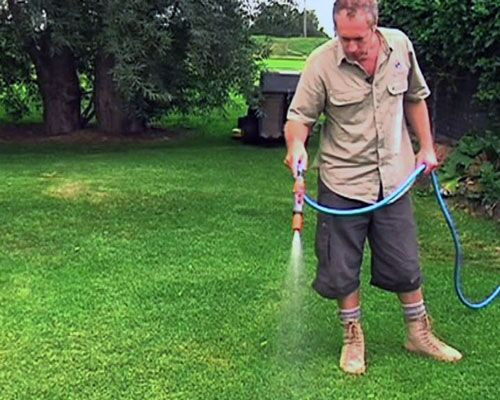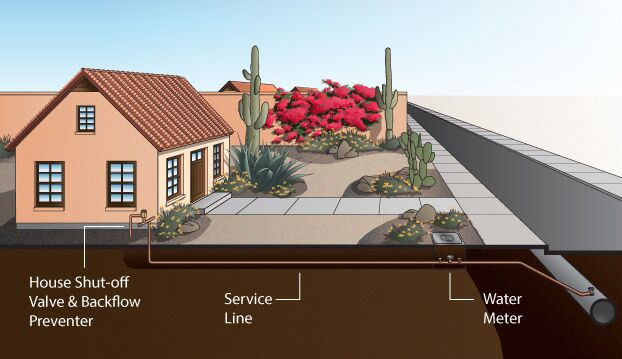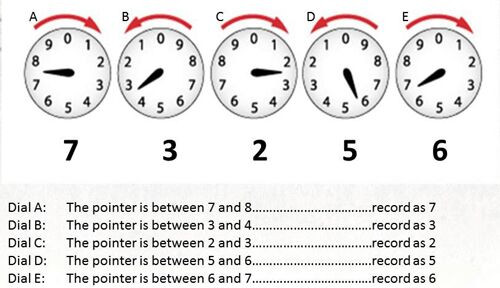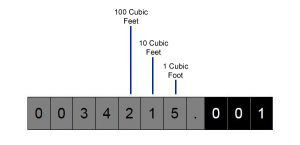Ever wondered why your water bill seems a bit off, or perhaps you’re just curious about your home’s water consumption? Understanding your water meter is the first step to taking control of your water usage and potentially saving money. But before you can leverage this handy device, you need to answer the fundamental question: “Where Is My Water Meter?”
This guide is designed to help you locate your water meter and understand how to read it. Think of your water meter as the unsung hero of your home’s plumbing system – a device that not only helps the utility company calculate your bill but also empowers you to monitor your water consumption and detect hidden leaks.
Understanding the Different Types of Water Meters
Just like watches come in analog and digital versions, water meters also have different display types. Knowing the type of meter you have is crucial for accurate reading. Generally, water meters fall into two main categories based on how they display water usage.
Common Types of Water Meters
There are primarily two common types of water meters you’ll encounter in residential settings: straight-reading meters and round-reading meters.
Straight-Reading Water Meters
Straight-reading meters are known for their simplicity and ease of use. They display the total water consumption in a linear, odometer-like fashion, making them straightforward to read at a glance. These meters are similar to the mileage counter in your car or a digital watch, presenting the numbers in a horizontal row.
- Analog Straight-Reading Meters: These feature mechanical digits that roll over to indicate water usage, much like an old car odometer.
- Digital Straight-Reading Meters: Modern homes may have digital versions that display the reading electronically, offering a clear and precise measurement.
 watering-lawn
watering-lawn
Alt text: Monitoring lawn watering with a home water meter to understand water usage and potential cost.
Round-Reading Water Meters
Round-reading meters, also known as dial meters, present a more traditional and sometimes slightly more complex display. They utilize a series of circular dials, typically five or six, each representing a different unit of measurement (e.g., 10, 100, 1000 cubic feet). Reading these meters requires interpreting each dial individually to calculate the total water usage.
Regardless of whether you have a straight-reading or round-reading meter, most include a small, often star-shaped or triangular pointer that rotates as water flows through the meter. This indicator is particularly useful for leak detection.
Finding Your Water Meter: Location, Location, Location
Now, let’s get to the heart of the matter: “Where is my water meter?” The location of your water meter can vary depending on your geographical location, the age of your home, and local plumbing practices. However, there are a few common places to check.
Where to Find Your Water Meter?
Your water meter is usually located in one of two primary locations: outdoors, typically in the front yard, or indoors, often in the basement or garage.
Outdoor Water Meter Locations
In many modern residential areas, especially those with warmer climates, the water meter is usually situated outside. Here’s how to find it outdoors:
- Meter Pit Near the Curb: The most common outdoor location is in a meter pit, also known as a meter box or meter vault. Look for a round or rectangular metal or concrete lid, usually about the size of a dinner plate, near the street curb in your front yard.
- Opening the Meter Pit: You might need a tool like a crowbar, pliers, or screwdriver to carefully lift the lid. Be cautious as meter boxes can sometimes house insects or spiders. Once open, you should see the water meter inside the pit.
 where is my water meter – in front yard
where is my water meter – in front yard
Alt text: Typical outdoor water meter location in a front yard meter pit near the street curb for residential homes.
Keep in mind that landscaping, such as shrubs, grass, or ground cover, might obscure the meter pit lid. You might need to carefully search and clear away any vegetation to locate it.
Indoor Water Meter Locations
In regions with colder climates where freezing temperatures are a concern, water meters are often located inside the house to prevent damage. Common indoor locations include:
- Basement: Check the basement walls, especially near the front of the house, for the water meter. It’s usually located where the main water line enters your home and is often near the main water shutoff valve.
- Garage: In some homes, particularly those without basements, the water meter might be in the garage, again, near where the water line enters.
- Utility Closet: Less commonly, but still possible, the water meter could be in a utility closet, sometimes shared with other utilities.
Dual Water Meter Systems
Some properties, especially larger ones or those with extensive landscaping, may have dual water meter systems. In these cases, one meter typically measures water used inside the house, while the second meter measures water used outdoors for irrigation or other external purposes. If you have a dual system, you’ll need to locate both meters to get a complete picture of your water consumption.
Mastering the Art of Reading Your Water Meter: Step-by-Step Guides
Once you’ve located your water meter, the next step is learning how to read it. Water meters measure water volume, typically in gallons or cubic feet. If your meter reads in cubic feet, remember that 1 cubic foot is approximately 7.48 gallons.
Here are step-by-step guides for reading the different types of water meters:
How to Read a 6-Dial Round-Reading Water Meter
- Start with the 100,000 Dial: Begin with the dial labeled “100,000” (or the highest value dial). Note the digit that the pointer is closest to. When the pointer is between two numbers, always record the smaller of the two.
- Proceed to Lower Dials: Systematically read each dial in descending order: 10,000, 1,000, 100, and 10. Follow the same rule – record the smaller number the pointer is nearest to. Note that the pointers on round-reading meters typically alternate direction (clockwise and counterclockwise) from one dial to the next, so pay attention to the direction of the numbers on each dial.
- Record the Reading: Write down the digits you’ve read from each dial consecutively, starting from the highest value dial to the lowest. This sequence of digits represents your current water meter reading in cubic feet.
- Ignore the “One Foot” Dial (for general reading): The 6th dial, often labeled “one foot” or similar, is usually used for very precise leak detection and is generally not needed for routine meter readings for billing purposes.
This method will give you the total cumulative water usage recorded by the meter.
How to Read a 5-Dial Round-Reading Water Meter
- Identify the Sweep Hand: The main difference between a 5-dial and 6-dial round-reading meter is that the 5-dial meter uses a large sweep hand that circles the outer edge of the meter face to indicate the flow of each cubic foot of water.
- Read the Dials: Read the five dials in the same manner as the 6-dial meter, starting from the highest value dial (usually 100,000) down to the 10 dial. Again, record the smaller number the pointer is closest to on each dial.
- Record the Reading: Write down the digits in order to get your reading in cubic feet. The sweep hand is used for more granular measurement and leak detection but isn’t typically part of the standard reading for billing.
 where is my water meter – 5 dials
where is my water meter – 5 dials
Alt text: Example of a 5-dial round-reading water meter face used to measure cumulative water consumption.
How to Read a Straight-Reading Water Meter
- Note the Numbers: Simply read the numbers displayed in a straight line from left to right, just like reading a car odometer. These numbers represent the total water consumption.
- Identify the Units: Determine whether the meter measures in cubic feet or gallons. This is usually indicated on the meter face itself (e.g., “Cubic Feet” or “Gallons”).
- Observe the Flow Indicator: Straight-reading meters often have a small dial or rotating indicator (often a triangle, star, or gear shape) that spins when water is flowing. This is useful for leak detection.
- Include All Digits: Record all the digits displayed, including any fixed zeros at the end. Some straight-reading meters might have a series of digits followed by one or two fixed zeros. Include all of these for your reading.
 where is my water meter – measure in cubic feet
where is my water meter – measure in cubic feet
Alt text: Straight-reading water meter displaying water usage in cubic feet with a visible flow indicator.
Understanding the units and the type of meter you have is key to accurately interpreting your water consumption.
Using Your Water Meter to Detect Leaks
Beyond billing, your water meter is an invaluable tool for detecting leaks in your plumbing system. Even small leaks can waste significant amounts of water and increase your water bill unnecessarily. Here’s how to use your water meter to check for leaks:
The Leak Detection Test
- Turn Off Water Usage: Ensure that no water is being used inside or outside your house. This means no running faucets, showers, dishwashers, washing machines, or sprinklers.
- Locate the Leak Indicator: Find the leak indicator on your water meter. This is typically a small, rapidly rotating dial, often triangle-shaped, star-shaped, or a small wheel. On digital meters, it might be a flashing icon or a similar indicator.
- Observe the Indicator: Watch the leak indicator closely for a few minutes.
- Interpret the Results:
- Indicator Moving: If the leak indicator is moving, even slowly, it means water is flowing through your meter even when all water is turned off in your house. This strongly suggests you have a leak somewhere in your plumbing system.
- Indicator Stationary: If the indicator remains perfectly still, it’s a good sign that you likely do not have any major leaks at that moment.
What to Do If You Suspect a Leak
If your water meter indicates a leak, the next step is to investigate further to pinpoint the source. Common culprits include leaky faucets, running toilets, and leaks in underground pipes. If you cannot easily identify and fix the leak yourself, it’s advisable to call a qualified plumber to help locate and repair the problem. Addressing leaks promptly can save water and reduce your water bills.
Final Thoughts
Knowing “where is my water meter” and how to read it is more than just a homeowner’s trivia – it’s a practical skill that can save you money and conserve water. By understanding your water meter, you gain valuable insights into your water consumption habits and equip yourself with the ability to detect costly leaks early. Take a few minutes to locate your meter and familiarize yourself with its readings. It’s a small step that can make a big difference in managing your home’s water efficiency.
Call 1-Tom-Plumber
Don’t hesitate to contact us here or call us at 1-Tom-Plumber (1-866-758-6237) if you have leaking, increasingly high water bills, or need a water meter repaired.
1-Tom-Plumber’s certified team of plumbers and drain technicians respond immediately to any emergency plumbing, drain cleaning, or water damage problem. We also handle the excavation of underground water lines and sewer main lines. Our immediate-response team is available every day and night of the year, even on holidays.
